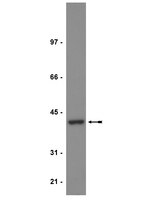Characterization of SET/I2PP2A isoforms in dogs.
Yabe, R; Fujiwara, N; Mizuno, T; Usui, T; Ohama, T; Sato, K
The Journal of veterinary medical science / the Japanese Society of Veterinary Science
76
1235-40
2014
요약 표시
SET is an endogenous protein phosphatase 2A (PP2A) inhibitor and is associated with a poor prognosis in human leukemia. Previously, we reported increased SET protein levels in canine lymphoma cell lines and the potential therapeutic application of SET antagonists in canine lymphoma. Here, we found that canine cells express several isoforms of the SET protein. We cloned 4 isoforms of SET, named SETα, β, γ and δ. Genomic BLAST showed that the SET genes are located on chromosomes X, 7, 1 and 8, respectively. An immunofluorescent study showed nuclear localization of SETα and β, and nuclear and cytosolic localization of SETγ and δ. We confirmed that SETα and β possess the ability to associate with PP2A. Our data reveal the existence of unique SET isoforms that should be taken into account in SET-targeting drug development studies in dogs. | | 24897959
 |
NNMT promotes epigenetic remodeling in cancer by creating a metabolic methylation sink.
Ulanovskaya, OA; Zuhl, AM; Cravatt, BF
Nature chemical biology
9
300-6
2013
요약 표시
Nicotinamide N-methyltransferase (NNMT) is overexpressed in a variety of human cancers, where it contributes to tumorigenesis by a mechanism that is still poorly understood. Here we show using metabolomics that NNMT impairs the methylation potential of cancer cells by consuming methyl units from S-adenosyl methionine to create the stable metabolic product 1-methylnicotinamide. As a result, NNMT-expressing cancer cells have an altered epigenetic state that includes hypomethylated histones and other cancer-related proteins combined with heightened expression of protumorigenic gene products. Our findings thus point to a direct mechanistic link between the deregulation of a metabolic enzyme and widespread changes in the methylation landscape of cancer cells. | Western Blotting | 23455543
 |
Phenylarsine oxide binding reveals redox-active and potential regulatory vicinal thiols on the catalytic subunit of protein phosphatase 2A.
Foley TD, Melideo SL, Healey AE, Lucas EJ, Koval JA
Neurochem Res
36
232-40. Epub 2010 Nov 16.
2011
요약 표시
Our earlier finding that the activity of protein phosphatase 2A from rat brain is inhibited by micromolar concentrations of the dithiol cross-linking reagent phenylarsine oxide (PAO) has encouraged the hypothesis that the catalytic subunit (PP2Ac) of PP2A contains one or more pairs of closely-spaced (vicinal) thiol pairs that may contribute to regulation of the enzyme. The results of the present study demonstrate using immobilized PAO-affinity chromatography that PP2Ac from rat brain formed stable DTT-sensitive adducts with PAO with or without associated regulatory subunits. In addition, a subset of the PAO-binding vicinal thiols of PP2Ac was readily oxidized to disulfide bonds in vitro. Importantly, a small fraction of PP2Ac was still found to contain disulfide bonds after applying stringent conditions designed to prevent protein disulfide bond formation during homogenization and fractionation of the brains. These findings establish the presence of potentially regulatory and redox-active PAO-binding vicinal thiols on the catalytic subunit of PP2A and suggest that a population of PP2Ac may contain disulfide bonds in vivo. | | 21080067
 |










